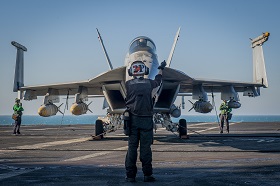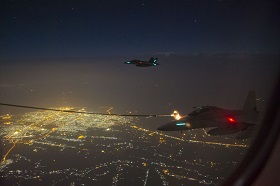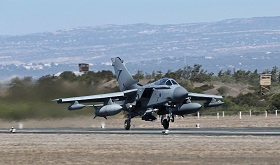The Third Crusade
CVN 70 "Carl Vinson" deck
(no votes) |
(0 votes) |
Research Fellow at the Primakov Institute of World Economy and International Relations under the Russian Academy of Sciences
December 18, 2011 was a momentous day for the U.S. Air Force: it flew the last combat sorties as part of Operation New Dawn, the final phase of the second Iraq War that began in 2003. For the first time since the start of the Desert Storm operation in 1991, U.S. war planes stopped combat operations over Iraq [1]. However, Iraq did not enjoy a peaceful sky for long. On August 8, 2014 two U.S. Navy carrier-based jet fighters struck Islamic State artillery units near Erbil, marking the start of a new war.
That is not quite the case, of course. The second horseman of the Apocalypse has not left these lands at least from the start of the Iran–Iraq war in 1980. Only the protagonists change (with the exception of Iraq itself). The new force is the Islamic State of Iraq, a terrorist group that sprang up in Iraq and achieved success in the civil war in Syria, success that enabled it to reformat itself, expand and get a new name – the Islamic State of Iraq and the Levant (ISIS) – and make a triumphant return to Iraq. During a lightning offensive in the summer of 2014, ISIS instantly occupied much of Northern Iraq. Within a matter of days, it had captured Mosul and Tikrit and on June 12 was on the approach to Baghdad, getting to within less than 100 km of the Iraqi capital. The Iraqi authorities promptly asked for U.S. military assistance.
Baghdad would inevitably have fallen if it were not for the emergence of a peoples’ militia and assistance from Iran, which sent its Islamic Revolutionary Guards to Iraq. In late June – early July, Russia and Iran sent several SU-25 assault aircraft to Iraq. At least some of these fighters, as well as those scrambled later, were flown by Iranian pilots [2]. These planes would later play an important role in fighting ISIS, carrying out a number of combat missions.

Su-25K, sent to Iraq by Iran
Baghdad would inevitably have fallen if it were not for the emergence of a peoples’ militia and assistance from Iran, which sent its Islamic Revolutionary Guards to Iraq.
It seems that the blitz ISIS offensive took the U.S. by surprise, at least temporarily. At the early stage of the conflict the Obama Administration took no decisive steps, content to watch the hostilities unfold from afar. After what remained of the Iraqi Armed Forces, assisted by the Islamic Revolutionary Guards, stopped the ISIS offensive against Baghdad, the main action shifted to the North – to Iraqi Kurdistan, which de jure is an autonomous area of Iraq, but de facto a quasi-state belonging to the Kurds. The Kurdish armed forces, called Peshmerga, are known to be resilient fighters. But they were struggling to defend the capital Ergil. The threat of a serious military defeat for the Kurds, one of the most capable forces in terms of could warding off ISIS, couple with the persisting serious threat to Baghdad, forced the United States to launch a military intervention in addition to supplying weapons to the Iraqi regime and the Kurds.
On August 7, 2014 President Obama made an official statement on Iraq, announcing that the United States was about to launch limited airstrikes on ISIS units and convoys. The official pretext given was the need to protect American citizens – diplomats, military advisors and civilians – in Ergil and Baghdad. The president also mentioned Yazidi refugees hiding from the militants in the mountains, whose plight was making headlines in the Western media at the time. When Barack Obama spoke it was already August 8 in Iraq.
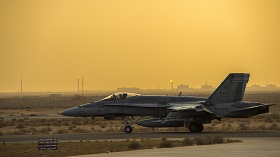
Canadian CF-18 "Hornet" in Kuwait
Uncertain “Inherent Resolve”
From the outset the U.S. leadership was apparently trying to carry out the operation in a way that would pass unnoticed for an American tax payer and voter. This is not surprising given that the Administration came to power on the back of an election campaign whose central premise was to “end the war in Iraq.” The U.S. Central Command [3] had to make do with its own resources. Luckily, a large Air Force was still stationed in the region, which again became a theatre of hostilities. Its exact composition was not publicized, but it certainly comprised several dozen planes. The signs are that there is no movement of really large forces at least remotely comparable in size to those committed in 1991 and 2003. There were no strategic aviation raids from U.S. territory (a small number of B-1B Lancer bombers that are taking part in the operation are launching their attacks from Qatar, where they have been based for a long time for actions in Afghanistan). In the Persian Gulf, there is just one U.S. Navy aircraft carrier on routine duty for that region; back in October, US Chief of Naval Operations Jon Greenert declared that there were no plans to send another aircraft carrier. For the sake of comparison, six carriers were committed for the invasion in 2003. Admiral Greenert also said that hazardous duty pay would not be reinstated.
The whole matter became somewhat absurd, with the operation not receiving its own code name, Inherent Resolve, until October 15. This is a totally unique case, especially considering the fact that America’s Western allies have always promptly named their own contributions to the intervention (Shader in Great Britain, Chammal in France, Impact in Canada, and Okra in Australia). In the overall context, the name “Inherent Resolve” smacks of the defence department taking a swipe at the political leadership.
On the whole, for the U.S. global war machine this is a regional war in the full sense of the word. Taking part in the operation are mainly local forces with small reinforcements.
During the first month the main role was played by CVN-77 George H.W. Bush carrier-based aircraft. The first strike was launched by two F/A-18F Super Hornets from Strike Fighter Squadron 213 (VFA-213). Its target was an ISIS artillery unit; two glide bombs destroyed two howitzers firing on Erbil. Ironically, they were US-made М198s left by withdrawing U.S. troops to the newly formed Iraqi army and seized by ISIS during its blitz offensive. Also involved in the operation were vertical take-off AV-8B Harrier aircraft from the LHD-5 Bataan amphibious assault ship, which delivered the first strike on August 8, 2014. The U.S. Air Force contributed F-15E Strike Eagle fighters and B-1B Lancer strategic bombers during the first month of the conflict. All in all, 100 combat missions were flown in August 2014, with 211 bombs and missiles used hereinafter referred to as air-launched weapons).
From the outset the U.S. leadership was apparently trying to carry out the operation in a way that would pass unnoticed for an American tax payer and voter.
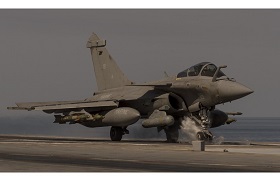
From the start of the operation one serious inconvenience for U.S. (and later coalition) aviation was the large distance between the main battle ground and the bases from which the aircraft were scrambled.
From the start of the operation one serious inconvenience for U.S. (and later coalition) aviation was the large distance between the main battle ground (northern Iraq and later northern Syria) and the bases from which the aircraft were scrambled. The distance between Qatar and the United Arab Emirates (where most U.S. Air Force planes are based) to northern Iraq is about 1,500 km. The distance from Kuwait to the northern coast of the Persian Gulf is shorter, but still out of range for ordinary fighter plane. This dictates extensive use of refuelling planes. For example, in August tankers flew 675 sorties pumping 1,800 tons of fuel into 3,971 planes in the air. The refuelling planes of course catered not only to the combat aircraft, but also to reconnaissance and transport planes (the latter were widely used to deliver weapons to loyalists and Kurd troops, as well as to deliver humanitarian aid). But even carrying out routine airstrikes often required planes to be refuelled in the air more than once.
Syria Becomes a Battlefield
However, the main dilemma in starting the operation was the expanded area of the airstrikes. Iraq was the frontline for ISIS, and it needed urgent actions to be saved. However, the rear of the terrorist group, the training camps and one of the main sources of its income – oil infrastructure and do-it-yourself oil refineries – were in Syria. There were no diplomatic or legal problems with Iraq, because for a long period the internationally recognized government of that country was quite sincerely asking the United States for any military assistance it could give. Things were much more complicated in the case of Syria. For understandable reasons, the United States could not officially come to an agreement with the Bashar al-Assad government: after all, it is still committed to supporting the “moderate” opposition and toppling the “illegitimate regime”. It is hard to say whether behind-the-scenes negotiations were held, but eventually the Department of State declared that strikes on the militants’ positions and infrastructure on Syrian territory would be launched “at the request of the Iraqi government,” which does not even require the approval of the UN Security Council.

French Mirage 2000 flies over Iraq
The Americans did not sign any official agreements with Syria, they merely “notified” its government about the planned strikes. Damascus replied rather obliquely that it had not been consulted, but that it of course welcomed the strikes against terrorists. However, the fact that U.S. aviation was aiming its strikes mainly at the places where ISIS was clashing with the Kurds and the lack, up until now, of cases of “friendly fire” from both sides (one should not forget that Syria has comparatively modern anti-aircraft weapons, as well as its own active air force) suggests that there must have been some agreements, at least with regard to “dividing territory”. It should be noted that earlier Syria, also at Baghdad’s request, was delivering strikes on ISIS positions on positions in Iraqi territory.
Once the diplomatic barriers were removed, early in the morning on September 23, the U.S. Air Force and Navy delivered what to this day remains the biggest strike on ISIS since the start of the operation. Three waves of aircraft attacked the infrastructure and positions of the militants in Syria; this involved the first ever combat mission of the fifth generation F-22A Raptor fighter plane. This was also the only time that sea-based Tomahawk cruise missiles were actively used.
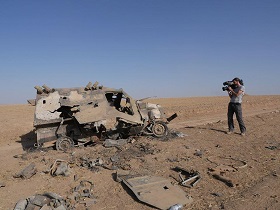
ISIS armored vehicle destroyed
Thereafter, during the course of the campaign, strikes on Syria were delivered more or less equally, with periodic shifts from one front to the other. The beleaguered government forces in Iraq needed strong support from time to time, so much so that AH-64 Apache helicopters of the small contingent of the U.S. Army stationed at Baghdad airport had to be pressed into service. The action in Syria in October concentrated on destroying the oil processing infrastructure to undermine ISIS sources of funds. Once that mission was fulfilled, most strikes began to be delivered on the “Kurdish Stalingrad” – the city of Kobani on the Syrian–Turkish border, which was the scene of the bloodiest battle in six months. The city and its suburbs were targeted by sometimes as many as 20 strikes a day, with the total number of strikes exceeding 700. The chiefs of the operation reported destroying more than 280 of the militants’ firing positions, 100 occupied buildings, 60 armed pick-up trucks [4] and a dozen tanks. It was not until January 27 that the Kurds, supported by air power, managed to drive the militants out of the devastated city.
Cobbling Together a Coalition
From the outset the United States sought to create a broad international coalition. This was necessary, first, to shore up the legitimacy of the strikes and ensure diplomatic and information support of the campaign internationally, and second, due to a reluctance to bring in additional reserves of its own. The key role in putting the coalition together was played by the conference held in Paris on 15 September.
From the beginning and up until now the United States’ allies are divided into two groups: the Arab Gulf countries and, loosely, the West.
The first group at present includes Bahrein, Jordan, Qatar, Saudi Arabia and the United Arab Emirates. These countries only strike militants’ positions in Syria. They largely go through the motions and their actions get little coverage, with no exact statistics. Their main benefit is that they provide additional legitimacy for strikes on Syria, which are not delivered single-handedly by the United States, but rather by a “broad antiterrorist coalition”, and that they make ground bases available.
The second group includes the United States’ main allies in the world: Australia, Belgium, Great Britain, Canada, Denmark, France and the Netherlands (with a bit of a stretch, we can also include Morocco in that group). These countries sent their contingents to bases in the Gulf countries, i.e. the United Arab Emirates, Jordan and Kuwait [5]. Most contingents are built around a small group of tactical multipurpose fighter planes (from six Belgian F-16AM Fighting Falcons or Canadian CF-188 Hornets to nine Rafale and five Mirage 2000 planes from France). Whenever possible, they are provided with a large long-range reconnaissance plane used to search for targets and monitor the effectiveness of strikes, an Airborne Warning and Control System (AWACS) and, of course, refuelling planes. Suffice it to say that as of January 31, U.S. tankers alone flew 5,950 missions and performed 36,591 refuelling operations.
Without a doubt, the strongest contingent was provided by France, which was also the first to join the strikes back on September 19. France is also planning to send its Charles de Gaulle nuclear-powered carrier to the Gulf. The decision was taken, by the way, before the terrorist attacks in Paris Its air force went into action on February 25. Other countries that contributed strong contingents are Great Britain and Australia.
The countries that make up this group only deliver strikes on militants’ positions in Iraq. The reason for this is the flimsy diplomatic grounds for strikes on Syria without the consent of the Bashar al-Assad government and/or sanctions of the UN Security Council. The only exception is Great Britain’s reconnaissance flights over Syria.
Successful cooperation of the Air Forces of so many countries is a good example of the high level of the interoperability and preparedness of Western countries for joint actions. Thus, air refuelling of one country’s planes by another country’s tankers, control of planes from several countries under a single command centre (AWACS), not to mention general planning at the United States Central Command located at the Al Udeid Air Base in Qatar are all routine operations.
In spite of its large number of allies, the U.S. air force had delivered up to 85 per cent of all strikes.
“Only the Dead Will See the End of the War”
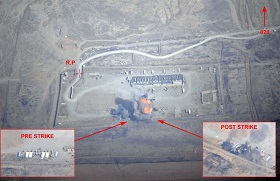
The first air strike executed by French
As of late January, a total of 1,919 airstrikes had been delivered, more than 6,000 militants had been killed, according to U.S. estimates, dozens of countries were to varying degrees involved in the coalition, and the United States alone was spending more than $8 million a day on the operation. The total cost by January 30 was $1.35 billion). However, in spite of all this, victory over ISIS is no nearer today than it was in August 2014. Yes, the Kurds have pushed the enemy away from their Iraqi capital of Erbil and won the gruelling battle for Kobani, and Iraqi government troops have stopped the offensive with Iran’s help. But the terrorists are still in control of a vast area. The opponents of ISIS display staunchness when fighting on territory they consider “their own”, but their offensive potential and manoeuvrability leave much to be desired. So far, the coalition has lost practically no aircraft whatsoever, with the exception of a Jordanian F-16C that was probably shot down by ISIS, although the exact cause of its loss is still unclear. However, this cannot last forever.
The militants have suffered heavy casualties, but they are being joined by a large number of volunteers not only from traditionally Islamic countries, but also from Europe and even the United States, Canada and Australia. ISIS has already struck at “the rear” by staging high-profile terrorist attacks in Great Britain, France and Canada and even in Australia, which until recently seemed far removed from radical Islam. Among their latest “exploits” were the execution of two Japanese citizenz (officially to punish Japan, which is not allowed to use its forces abroad under its Constitution, for giving financial aid to the coalition), the burning alive of a captured Jordanian pilot of an F-16C, and the decapitation of 21 Egyptians for the simple reason that they were preaching Christianity (Egypt responded by launching air strikes on ISIS positions in Libya).
So this latest war in the Middle East looks set to continue for a long time. The air campaign is likely to expand in 2015: it is no coincidence that the use of airborne weapons rose December 2014 (1,867) and January 2015 (2,308). Pentagon Press Secretary John Kirby candidly admitted that he did not know how much time it would take to defeat ISIS, “we have said it is probably going to take three to five years”. It looks like the United States has another very unpleasant war on its hands, a war to which there is no end in sight.
1. After the end of Desert Storm no-fly zones were established over Northern and Southern Iraq which were patrolled by international (mainly American) air forces up until the start of the second Iraq War. In the process, regular strikes were delivered on land targets, mainly anti-aircraft systems. Occasionally things heated up during that period, for example during Operation Desert Fox on December 16–19, 1998 when massive strikes were launched on military infrastructure all over Iraq.
2. AirForces Monthly, February 2015
3. It is worth noting that the designation “Central” in the name does not indicate a dominant status. The Central Command is one of the regional commands responsible for operations in the Middle East, North Africa and Central Asia. There exists also the African Command and the Pacific Command.
4. An armed civilian vehicle is as a rule a pickup truck with a large-calibre machine gun.
5. The only exception is Great Britain, whose air group operates from its airbase in Akrotiri in Cyprus. It is also the only ally that flies towards the theatre of operations from the Eastern Mediterranean.
(no votes) |
(0 votes) |


